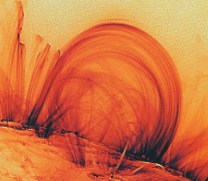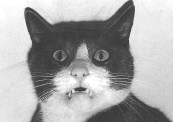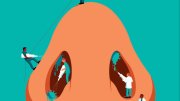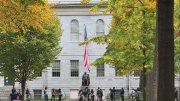 |
| Detail of an image of the million-degree solar corona taken by the TRACE satellite, from Nearest Star. |
| Lockheed Martin/NASA |
Minutes to Burn, by Gregg Andrew Hurwitz '95 (HarperCollins, $25). The year is 2007. Earthquakes and hurricanes rack the Western Hemisphere. The sun crisps skin in minutes because of a depleted ozone layer. Two scientists go to the Galápagos to position critical tectonic equipment. Confident that they have here a summer blockbuster novel, the publishers sent along with a review copy a complimentary bottle of sunblock.
Mosquito: A Natural History of Man's Most Persistent and Deadly Foe, by Andrew Spielman and Michael D'Antonio (Hyperion, $21.95). More summer reading. Spielman is professor of tropical public health at Harvard and D'Antonio is a journalist. Their protagonist is "a nuisance, a pain, and an angel of death."
1688: A Global History, by John E. Wills Jr., Ph.D. '67 (Norton, $27.95). A professor of history at the University of Southern California gives readers a stylish account of what was happening and being thought in Europe, Russia, China, Japan, Africa, and the Americas at the dawn of modern times.
Radiant Hunger, by Diane Lefer '72 (Authors Choice Press, $16.95, paper). On a back road, a devastated family and an apocalyptic cult violently intersect.
On the Wing: A Young American Abroad, by Nora Sayre '54 (Counterpoint, $25). After Harvard, in wet, green London, Sayre continued her education through encounters with Charlie Chaplin, Graham Greene, Arthur Koestler, Cyril Connolly, Tyrone Power, Donald Ogden Stewart, and a number of "fat men with dazzling vocabularies," among them A.J. Liebling. "Today a memoir is expected to feature a disaster" and "buckets of boohoo," writes Sayre. But this one is full of wit and vivid portraiture.
 |
| Ernie, from Ernie |
Out of Its Mind: Psychiatry in Crisis: A Call for Reform, by J. Allan Hobson, M.D. '59, and Jonathan Leonard '63 (Perseus Publishing, $26). The authors argue for a new psychiatry that combines traditional counseling with what neuroscience has recently discovered about how the brain and human beings work. Hobson is professor of psychiatry at the Medical School; Leonard is a science writer and contributor to this magazine.
Brand New: How Entrepreneurs Earned Consumers' Trust from Wedgwood to Dell, by Nancy F. Koehn, M.P.P. '83, Ph.D. '90 (Harvard Business School Press, $39.95). An associate professor at the Business School explains how a successful brand is built through well-wrought profiles of six visionaries: Josiah Wedgwood, Henry Heinz, Marshall Field, Estée Lauder, Howard Schultz of Starbucks, and Michael Dell.
A Nurse's Story and Others, by Peter Baida '72 (University Press of Mississippi, $25). The author collected 22 rejection slips for "A Nurse's Story" before the Gettysburg Review took it. The piece won first prize in the 1999 O. Henry Short Story Awards. Baida died of hemophilia and cancer shortly thereafter at 49. Writes storyteller John Barth of this posthumous collection, "Tough love and unsentimental compassion for the old, infirm, and fallen run through these wise and moving stories."
Arthur W. Page: Publisher, Public Relations Pioneer, Patriot, by Noel L. Griese (Anvil Publishers, $24.95). A 1905 graduate of Harvard, Page was a vice president of Doubleday Page & Company and then the first public-relations vice president of AT&T. Griese calls him a giant "in the canonical hierarchy of public relations." For Harvard he served as Overseer, raised funds for the Center for the Study of Liberty in America, and gave public-relations advice, apparently including a suggestion that President Conant interfere with the editorial independence of this magazine.





